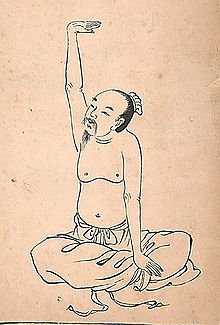Baduanjin qigong
| Baduanjin qigong | |||||||

|
|||||||
| Traditional Chinese | |||||||
|---|---|---|---|---|---|---|---|
| Simplified Chinese | |||||||
|
|||||||
| Transcriptions | |
|---|---|
| Standard Mandarin | |
| Hanyu Pinyin | Bāduànjǐn |
The Baduanjin qigong(八段錦) is one of the most common forms of Chinese qigong used as exercise. Variously translated as Eight Pieces of Brocade, Eight-Section Brocade, Eight Silken Movements or Eight Silk Weaving, the name of the form generally refers to how the eight individual movements of the form characterize and impart a silken quality (like that of a piece of brocade) to the body and its energy. The Baduanjin is primarily designated as a form of medical qigong, meant to improve health. This is in contrast to religious or martial forms of qigong. However, this categorization does not preclude the form's use by martial artists as a supplementary exercise, and this practice is frequent.
This exercise is mentioned in several encyclopedias originating from the Song Dynasty. The Pivot of the Way (Dao Shi, c. 1150) describes an archaic form of this qigong. The Ten Compilations on Cultivating Perfection (Xiuzhen shi-shu, c. 1300) features illustrations of all eight movements. The same work assigns the creation of this exercise to two of the Eight Immortals, namely Zhongli Quan and Lü Dongbin.
The exercise was later expanded from eight to twelve movements over the centuries and was described in the boxing manual Illustrated Exposition of Internal Techniques (1882) by Wang Zuyuan, a famed practitioner of the Sinew Changing Classic set.
Nineteenth century sources attribute the style to semi-legendary Chinese folk hero General Yue Fei, and describe it as being created as a form of exercise for his soldiers. The legend states he taught the exercise to his men to help keep their bodies strong and well-prepared for battle. Martial historian Prof. Meir Shahar notes Yue's mention as a lineage master in the second preface of the Sinew Changing Classic manual (1624) is the reason why he was attributed as the creator of Baduanjin qigong.
The Baduanjin as a whole is broken down into eight separate exercises, each focusing on a different physical area and qi meridian. The Baduanjin traditionally contains both a standing and seated set of eight postures each. In the modern era, the standing version is by far the most widely practiced. The particular order in which the eight pieces are executed sometimes varies, with the following order being the most common.
...
Wikipedia
